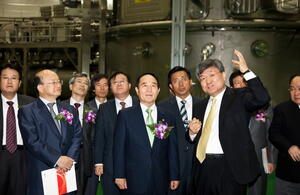KSTAR in physics operation
On 9 September, a ceremony was held announcing the beginning of KSTAR physics operation with the participation of 150 dignitaries including the Minister of Education, Science & Technology (MEST), heads of scientific and technical research institutions and National Assembly members.
Work on KSTAR started in 1995, and was completed twelve years later in September 2007 to the cost of 309 billion won (EUR 180 million). Last July, KSTAR successfully produced its First Plasma, fulfilling commissioning goals. The First Plasma targets of 100kA lasting 0.1 s at the magnetic fields of 1.5T were successfully achieved in the first trial, without any severe fault.
The targets of this year include producing plasma pulses lasting up to 2 s at currents of 300kA with magnetic fields reaching 3T. Currently, the superconducting magnets are being cooled and it is planned to start producing plasma in mid-October, with target parameters reached by November.
During this campaign, the National Fusion Research Institute (NFRI) will be engaged in exercises involving long-duration fusion plasma operation, and elaborate plasma control. Other activities will include basic fusion research and joint programs with academic and research institutions to develop human resources. International collaborations with the ITER Organization, the Princeton Plasma Physics Laboratory, General Atomics and other institutions are also scheduled.
Beginning its physics operation, KSTAR takes the first step toward the full-blown fusion research program planned through 2025. The operational target is to achieve high performance steady-state plasmas at 2MA with pulse lengths reaching 300 s.


